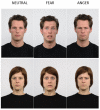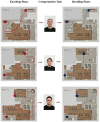The effect of negative emotion processing on spatial navigation: an experimental study using virtual reality
- PMID: 38274671
- PMCID: PMC10808736
- DOI: 10.3389/fpsyg.2023.1301981
The effect of negative emotion processing on spatial navigation: an experimental study using virtual reality
Abstract
Finding one's way in unfamiliar environments is an essential ability. When navigating, people are overwhelmed with an enormous amount of information. However, some information might be more relevant than others. Despite the mounting knowledge about the mechanisms underlying orientational skills, and the notable effects of facial emotions on human behavior, little is known about emotions' effects on spatial navigation. Hereby, this study aimed to explore how exposure to others' negative emotional facial expressions affects wayfinding performances. Moreover, gender differences that characterize both processes were considered. Fifty-five participants (31 females) entered twice in three realistic virtual reality environments: the first time, to encode a route to find an object and then to recall the learned path to reach the same object again. In between the two explorations of the virtual environment, participants were asked to undergo a gender categorization task during which they were exposed to sixty faces showing either neutral, fearful, or angry expressions. Results showed a significant interaction between emotions, time, and gender. In particular, the exposition to fearful faces, but not angry and neutral ones, decreased males' wayfinding performances (i.e., travel times and distance travelled), while females' performances were unaffected. Possible explanations for such gender and emotional dissimilarities are discussed.
Keywords: emotions; faces; fear; spatial navigation; virtual reality.
Copyright © 2024 Mohamed Aly, Masi, Montanaro and Ricciardelli.
Conflict of interest statement
The authors declare that the research was conducted in the absence of any commercial or financial relationships that could be construed as a potential conflict of interest. The author(s) declared that they were an editorial board member of Frontiers, at the time of submission. This had no impact on the peer review process and the final decision.
Figures






References
-
- Adams R. B., Ambady N., Macrae C. N., Kleck R. E. (2006). Emotional expressions forecast approach-avoidance behavior. Motiv. Emot. 30, 177–186. doi: 10.1007/s11031-006-9020-2 - DOI
-
- Baenninger M., Newcombe N. (1989). The role of experience in spatial test performance: a meta-analysis. Sex Roles 20, 327–344. doi: 10.1007/BF00287729 - DOI
-
- Barsade S. G. (2002). The ripple effect: emotional contagion and its influence on group behavior. Adm. Sci. Q. 47, 644–675. doi: 10.2307/3094912 - DOI
LinkOut - more resources
Full Text Sources

